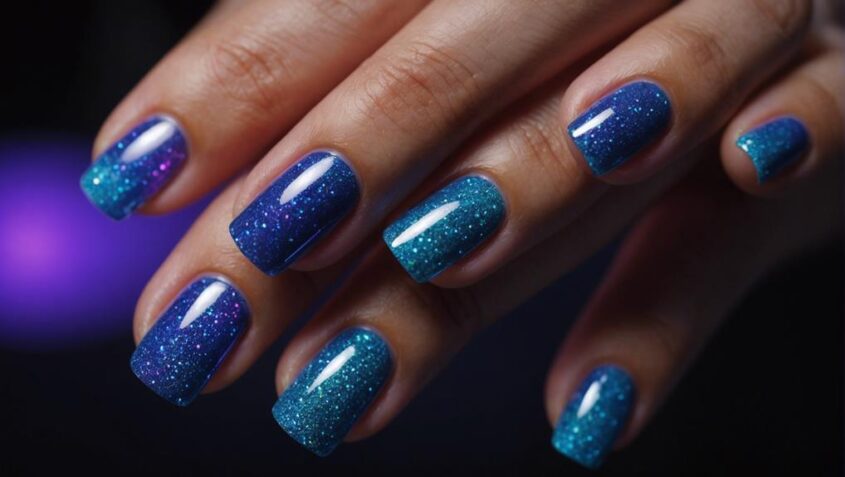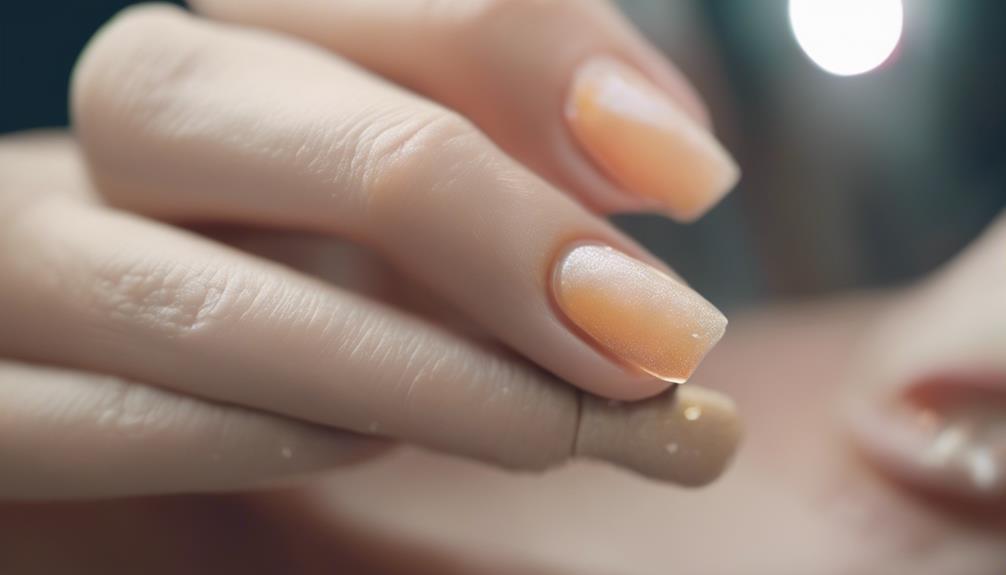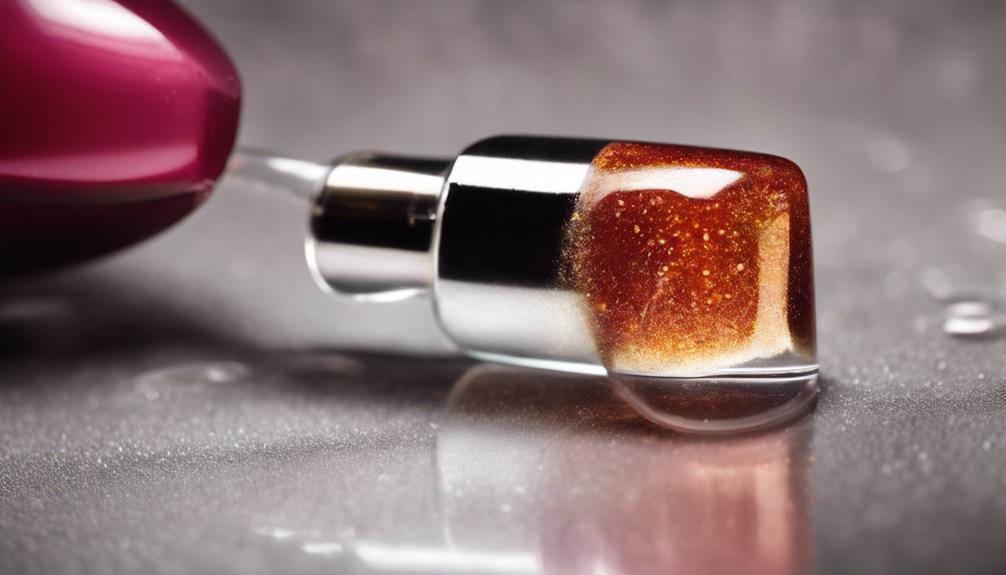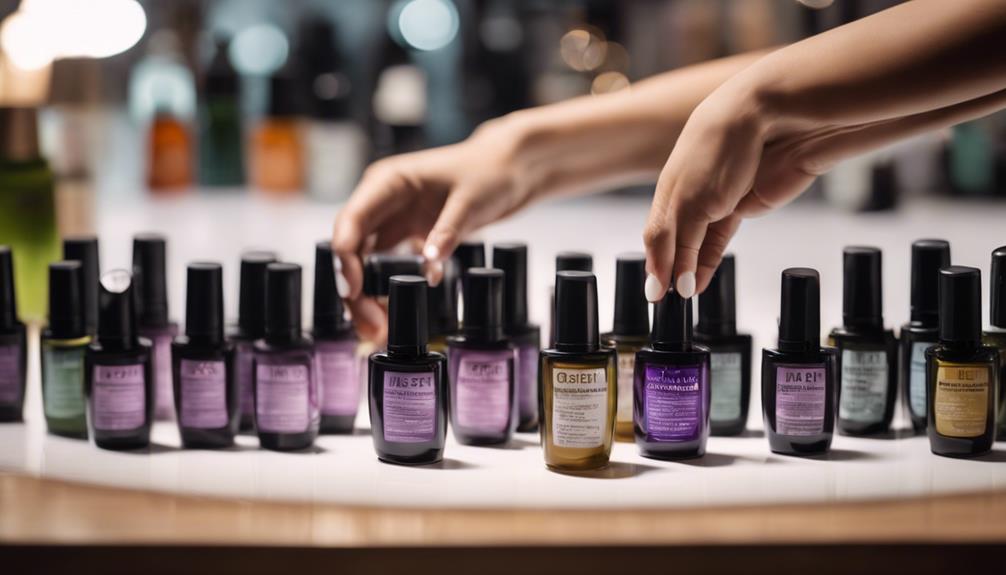What Happens if You Cure Gel Polish Over Regular Polish?

Curing gel polish over regular polish can cause chemical reactions and compatibility issues. The different curing methods and ingredients may lead to bubbling, peeling, or improper curing. To prevent this, use a high-quality base coat or check compatibility before application. Properly preparing the nail surface is crucial for adhesion and longevity. Uneven application, color blending issues, and texture changes can occur. Removal might be challenging, and health risks due to chemicals are possible. Expert recommendations on nail preparation and product use are valuable. Discover more about the effects and best practices to maintain a flawless manicure.
Key Takeaways
- Chemical reactions may cause bubbling, peeling, or improper curing.
- Color blending issues and texture changes can occur unpredictably.
- Gel and regular polish may not bond well, leading to chipping.
- Compatibility issues can affect adhesion and longevity of the manicure.
- Using high-quality base coats and proper removal techniques is crucial for nail health.
Potential Chemical Reactions

When combining gel polish over regular polish, potential chemical reactions may arise due to the differing formulations of the two products. Gel polish is a type of nail polish that requires curing under a UV or LED lamp to harden and adhere to the nail. On the other hand, regular nail polish dries through evaporation, forming a hard film on the nail surface. These distinct curing mechanisms can lead to incompatibilities when layered together. The solvents, resins, and pigments present in regular polish may not interact well with the ingredients in gel polish, potentially causing issues such as bubbling, peeling, or improper curing.
To mitigate the risk of chemical reactions when layering gel polish over regular polish, it is essential to ensure that the regular polish is fully dried and cured before applying the gel polish. Additionally, using a high-quality base coat can create a barrier between the two polish types, reducing the likelihood of adverse reactions. By understanding the formulations and curing processes of both products, nail technicians can innovate and experiment safely to achieve unique nail designs without compromising the integrity of the manicure.
Adhesion and Longevity Factors
Factors influencing the adhesion and longevity of gel polish applied over regular polish include the preparation of the nail surface and the compatibility between the two types of nail products. Properly preparing the nail surface is crucial for promoting adhesion. This involves thorough cleaning to remove any oils or residues that could hinder the bond between the regular polish and the gel polish. Additionally, lightly buffing the nail can create a slightly rough surface for better adhesion.
Compatibility between the regular polish and gel polish is essential for long-lasting results. Some regular polishes may contain ingredients that are not compatible with the gel formula, leading to premature peeling or lifting. To achieve the best outcome, it's recommended to use products from the same brand or ensure compatibility between the regular polish and gel polish through testing.
Appearance and Texture Changes

When curing gel polish over regular polish, it's crucial to consider potential appearance and texture changes. Issues like color blending can arise, leading to a less uniform finish. Uneven application of the polish may also impact the overall look and feel of the manicure.
Color Blending Issues
Given the intricate nature of gel polish curing over regular polish, color blending issues can arise, leading to noticeable changes in both appearance and texture. When gel polish is applied over regular polish, the different chemical compositions can interact unpredictably. This can result in color shifting, where the hues of the polishes mix, creating unintended shades. Additionally, the texture may become uneven due to the varying consistencies of gel and regular polish. To mitigate these color blending issues, it is essential to ensure that the regular polish is fully dried before applying the gel polish. This simple step can help maintain the integrity of the colors and textures, ensuring a smooth and professional-looking manicure.
Uneven Polish Application
To ensure a flawless manicure, attention must be given to the even application of polish, as any inconsistencies in application can lead to noticeable changes in both appearance and texture. Uneven polish application can result in a variety of issues such as streaks, bumps, and an overall unprofessional finish. When gel polish is cured over regular polish that has been unevenly applied, the curing process can accentuate these imperfections, making them more pronounced. This can create a bumpy texture on the nail surface and cause the polish to chip or peel more easily. It is essential to apply polish evenly to achieve a smooth and long-lasting manicure.
| Effects of Uneven Polish Application |
|---|
| Streaks |
| Bumps |
| Chipping |
| Peeling |
| Unprofessional appearance |
Removal Challenges
Addressing the removal challenges associated with curing gel polish over regular polish requires a strategic approach to prevent damage and ensure a smooth process. When gel polish is applied over regular polish, the layers bond together, making it difficult to remove them without causing harm to the natural nail. One of the main challenges is that regular polish does not bond well with the gel formula, leading to peeling and chipping during removal. This can result in a time-consuming and frustrating experience for both nail technicians and clients.
To overcome these challenges, it is essential to use acetone-based polish removers specifically designed for gel polish removal. These removers effectively break down the gel polish without damaging the underlying regular polish or the natural nail. Additionally, wrapping the nails in acetone-soaked cotton and securing them with foil helps to concentrate the remover on the gel polish while protecting the regular polish.
Health and Safety Concerns

Health and Safety Concerns Regarding Gel Polish Application
Ensuring the proper health and safety measures during gel polish application is paramount in maintaining a secure and hygienic environment for both nail technicians and clients. One significant concern is the potential risk of exposure to harmful chemicals present in gel polish formulations. Some gel polishes contain ingredients like formaldehyde, toluene, and dibutyl phthalate, which are known to have adverse health effects. Prolonged or excessive exposure to these chemicals can lead to skin irritation, respiratory issues, and in severe cases, more serious health complications.
Moreover, improper curing techniques, such as using the wrong type of lamp or not allowing enough time for each layer to cure properly, can result in under-cured gel polish. This not only affects the durability and appearance of the manicure but also increases the risk of allergic reactions or skin sensitivities. Additionally, inadequate sanitation practices, such as reusing tools without proper sterilization, can lead to the spread of infections and bacteria, posing a threat to both clients and technicians. Overall, prioritizing health and safety protocols in gel polish application is essential for creating a safe and enjoyable experience for everyone involved.
Expert Recommendations
When it comes to curing gel polish over regular polish, seeking expert recommendations is crucial for achieving the best results. Professionals can provide valuable advice on proper application techniques and best practices to ensure a flawless finish. By following expert guidance, individuals can enhance their nail care routine and maintain healthy, beautiful nails.
Expert Advice
To optimize the outcome of curing gel polish over regular polish, professional nail technicians recommend applying a thin layer of gel top coat for enhanced durability and shine. This additional step helps seal in the regular polish, providing a longer-lasting and glossy finish. Here are three expert recommendations to consider when curing gel polish over regular polish:
- Prep Work: Ensure the nails are properly cleaned, buffed, and primed before applying any polish layers.
- Thin Layers: Apply thin, even layers of both regular polish and gel polish to prevent bubbling or uneven curing.
- Curing Time: Follow the manufacturer's instructions for curing times to achieve the best results without damaging the nails.
Best Practices
Implementing proper techniques when applying gel polish over regular polish is crucial for achieving a flawless and long-lasting manicure. To ensure the best results, start by thoroughly cleaning the nails and removing any oils or residue. Next, apply a thin layer of regular polish and allow it to dry completely before adding the gel polish. When curing the gel polish, follow the manufacturer's instructions carefully regarding curing times and use an LED or UV lamp for optimal results. Remember to cap the free edge of the nail with both the regular polish and gel polish layers to seal the manicure and prevent chipping. By following these best practices, you can create a stunning manicure that combines the benefits of regular and gel polish seamlessly.
Frequently Asked Questions
Will Curing Gel Polish Over Regular Polish Create a Thicker Nail Surface?
Curing gel polish over regular polish may result in a thicker nail surface due to the additional layers. This technique can potentially enhance durability but may also lead to a less natural look.
Can Curing Both Polishes Together Damage the Natural Nail?
Curing both gel and regular polish together can damage the natural nail due to uneven adhesion, leading to premature lifting and potential nail weakness. Properly layering and curing each polish separately is recommended to maintain nail health.
How Does Curing Affect the Overall Drying Time of the Manicure?
Curing gel polish significantly reduces drying time, offering a faster and more efficient manicure experience. This advanced technology accelerates the polymerization process, creating a durable and long-lasting finish. Embrace innovation for a flawless nail treatment.
Is It Possible to Prevent Chipping or Peeling With This Technique?
Preventing chipping or peeling when applying gel polish over regular polish involves meticulous prep work and strategic layering techniques. By ensuring a clean, dry base and applying thin, even coats, the risk of chipping or peeling can be significantly reduced.
Will Curing Mixed Polishes Result in a Different Finish Than Expected?
Curing mixed polishes can lead to unexpected finishes due to chemical reactions. Combining products designed for different curing methods can result in uneven textures or diminished longevity. It's crucial to adhere to manufacturer guidelines for optimal results.




